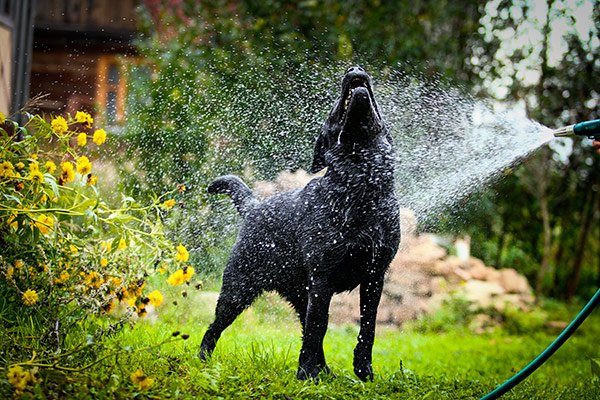
We Tried 5 Fresh Dog Food Brands
Is all the marketing hype worth it? Did our dogs enjoy them? Here’s our dogs’ totally honest review.
The Labrador Retriever is an excellent choice for many types of homes. Whether you live alone or with family or other, the Labrador can easily adapt to your household. He is therefore an excellent dog that will be happy no matter his environment.
This is a fairly robust breed but subject to a few health problems. Because this dog loves eating, it is important to monitor the amount of food you give him.
He is generally a good watchdog that seeks to protect his family members. He is very gentle, social, quite docile but sometimes stubborn.
Although he may be obstinate, he generally follows instructions. He becomes a puppy again when he spots a water area. His passion for water is eternal. Even a swimming pool is appealing to the Labrador Retriever. Because he is easy to train, he can easily learn how to get out of the pool using the steps or ladders.
Even as an adult, this dog retains the characteristics of a puppy. He remains a bit mischievous, playful and always ready to run and play with children and adults.
He is docile, very loyal and always comes back home. If you live in the country, this dog will be tempted to go after geese and other prey but will always return home. It’s in his nature.
The Labrador is highly valued by support organisations because he is easy to train. It takes little time for this dog to trust his owners and to harmonize with his new surroundings.


If he is fed too much, the Labrador will be prone to obesity. The Labrador Retriever is always hungry. Hence, it is critical to make sure he exercises on a regular basis.
Physically, he looks like the Newfoundland dog but he is actually smaller, his coat is less dense and his hair shorter. He is fond of aquatic activities and loves exercising and playing.
Between 57 and 62 cm (22.44 to 24.41 inches) for the male
Between 55 and 60 cm (21.65 to 23.62 inches) for the female
Between 29 and 36 kg (63.93 to 79.37 pounds) for the male
Between 25 and 32 kg (55.12 to 70.55 pounds) for the female
This breed exists in different colors including black, blond (which may be reddish) or chocolate brown. There are also some colors not recognized by international clubs such as white or silver.
His waterproof coat is short, very smooth and dries quickly. He does not tend to shed except during the change of seasons, like spring and fall.
His skull is large and his nose is well defined. He has medium size hazelnut or brown eyes. His ears are set back and hanging. His jaw is powerful. His tail is unique – it is unlike any other breed’s tail.
According to the FCI breeds nomenclature, this breed belongs to group 8, section 1 and is #122
Does this dog suit your lifestyle?
Every dog breed has its own characteristics. However, the actual character of a dog can vary from one to another within the same breed.
Find out if the Labrador Retriever is your ideal dog breed with our quiz.
That will take you less than 3 minutes!
Take the quiz






If you want your Labrador Retriever to stay healthy, he will need to be stimulated physically and mentally many hours a day. Ideally, your backyard should be fenced. However, if you live in an apartment or condo, you will need to plan regular trips to the nearest park. Nonetheless, know that the Labrador adapts well to all lifestyles.
Even though the Labrador is devoid of any aggressivity, socialization with children, other pets and adults should be done at a very young age. Because he has a very powerful jaw, unfortunate accidents must be avoided. By developing good habits at the time of adoption, you will have the opportunity to live with a superb family companion.
Because the Labrador is a large dog, this breed is sometimes plagued with hip problems. This is why it is essential to monitor the dog’s weight and avoid obesity, as this could cause hip problems as he gets older.
It is also important to feed him nutritious food so that he maintains a smooth and healthy coat. Other joint problems may arise, such as hip dysplasia and osteochondritis.
Lipoma, osteoarthritis, skin diseases and eye problems are other health issues encountered with this breed.
Still, the Labrador is considered as a very robust breed.
GROOMING
Depending on the environment where the Labrador lives, you should be prepared to bathe your Labrador about once every four months. Plan to brush him minimum once a week but twice a week is recommended.
During shedding season, brushing should be done on a daily basis. By cleaning his ears regularly, you will prevent the risk of ear infection. His nails should be trimmed as needed.
The term "Retriever" refers to the dog’s abilities to hunt and carry live or dead prey in his mouth whereas the term "Labrador" refers to the region in Canada.
The Labrador is a descendant of the St. John’s water dog. This webbed feet dog is very fond of fish. He was initially appreciated for his swimming abilities before being used as a hunting dog.
Thanks to his remarkable sense of smell, he is valued by hunters in woods, ponds and swamps. He is also widely used as a pet and as a service dog for the blind, the disabled, the elderly and for other people requiring particular attention.

Is all the marketing hype worth it? Did our dogs enjoy them? Here’s our dogs’ totally honest review.